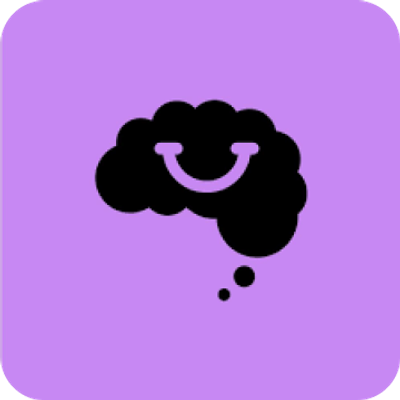How meditation works
Your mind can be an unruly place. Left to its own devices, your thoughts can run amuck and contribute to negative feelings like stress and overwhelm – often without you even realising. Meditation can help you take back some of the power that thoughts have over your feelings and experiences – making it a truly useful tool when you’re ready to start to work on feeling better.
Meditation helps give you insight into the contents of your mind in a non-judgmental way. It works by focusing your attention and interrupting the constant stream of tangled ideas and thoughts that pass through at any given moment.
Learning to focus attention in this way may give you back a sense of control over your mind; helping you feel calmer and clearer about your experiences. Plus, it has many other proven benefits like increasing patience and self-control, improving attention span and sleep, and helping you better manage stress.
“If I’m tossing and turning at night, I put on a guided meditation to reset my mind. I find it soothes my racing thoughts and just calms me down, helping me go back to sleep.”
What meditation is and isn’t
People often confuse feel-good activities like gardening, cooking or dancing with meditation. These are wonderful, relaxing self-care activities that can be useful to unwind. But (generally) they aren’t meditation.
Meditation is more akin to brain training than a feel-good activity. It teaches you to have greater control over your mind by cultivating a heightened state of awareness and focus to the present moment. It’s training you to pay attention to all types of thoughts and feelings – both positive and negative – without getting swept up or lost in them.
Your brain doesn’t come wired with this ability, so it is a skill that takes practice and training. Just like when you learn to juggle or ride a bike, you may not notice any difference after the first (or even the fifth) attempt – but the more practice you do to build that mental muscle, the greater the benefits you’ll receive. And eventually, meditation will become a skill you can bring to any part of your day.
“Meditation helps put me in the driver's seat of my mind.”
Watch this video to learn more about meditation and how to practise it.
How to meditate
This is a brand new skill, so you may find it useful to have a guide. This is essentially a virtual teacher who will offer instructions to improve your practice. There are many guided meditation tools online including Calm and Smiling Mind, a free, easy-to-use app or website you can try today.
You may also find having an ‘in-person’ meditation teacher or joining a group more motivating and beneficial. You could also try a combination of these and see what suits you.
This is how a meditation practice could look for you:
- Set a time to practice that feels right for you. Mornings are usually most effective, but any time is fine too
- You’ll need a quiet place where you can expect to be free of distractions or interruptions
- Start by lying down or sitting in a comfortable upright position - you may be cross-legged or not. Hands can rest on your lap or body, what’s most important is you’re comfortable.
- Eyes can be closed or open, but closed eyes will help quieten your mind
- Begin to let go of tension in your body and muscles; relaxing around your eyes, face, forehead, and then through your shoulders, arms, chest and legs
- Choose, and tune into your ‘anchor’ – this will act as a ‘refocusing tool’ throughout your practice. Whenever you catch your mind wandering, gently return your attention to your anchor. You can choose any anchor that works for you, it may be the inhale and exhale of your breath, sensations in your nose, feet or hands, the sounds around you, or an object you’re looking at.
- Notice thoughts, feelings and sensations as they arise – without judgement. It may be helpful to imagine each thought as a leaf floating through the stream of your thoughts. Rather than getting swept up in it, try letting it simply pass.
- Whenever you get distracted or lost in thought, as everyone does, simply return to your anchor. Try not to criticise yourself for getting distracted, rather congratulate yourself for noticing it!
- Continue until time is up. It’s not important how long you go for, but that you practice regularly. Try starting with 5 minutes and gradually increase it over time.
- End with a few moments of reflection. If you cultivated positive feelings from the practice, bask in that for a little longer – maybe even try carrying that feeling with you for the rest of the day. If more difficult thoughts or emotions arose – know that’s perfectly ok too.
- Thank yourself for practising and taking the time to work on your mental wellbeing.
“After a hard or overwhelming day, I use meditation to clear my head, relax and be present to what comes up.”
Making your routine stick
Now you know what meditation is and how to practice it, here are 3 tips for creating a routine that sticks.
- Aim small
It sounds counter-intuitive, but science has proven time and time again that when it comes to setting new routines, small, achievable goals are the way to go. So, start with just 5 minutes a day. Build to 10 minutes (and beyond) once you start to feel comfortable. Some days will be harder than others, or you might want to stop early, and that’s totally fine.
- Same time, same place
Carve out a consistent time and place to meditate. Some say morning meditation is ideal as it sets you up for the day. Others say the evening is best, once the ‘work day’ (for most) has ended. However, it’s good to experiment and find what works for you.
If that means squeezing in a few minutes after lunch or before bed, that’s fine too. When it comes to your meditation place, aim for somewhere with limited distractions and stimulation – perhaps a bedroom, study or anywhere you won’t be interrupted.
- Know your 'why'
A meditation routine takes time and repetition to stick. So, along the way, you may find your brain putting up a few roadblocks or reasons not to practice, particularly when times get tough or if negative feelings show up while meditating.
Knowing why your practice is important to you will help during those times. Your ‘why’ could be ‘to feel better’, ‘to stop looping thoughts’ or ‘to build mental fitness.’ Whatever it is, write it down or voice it aloud, and come back to it when times get tough, to help your meditation routine stick.







